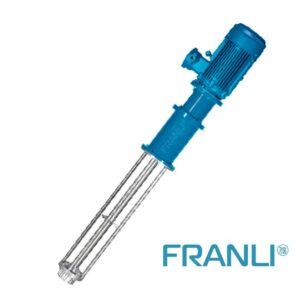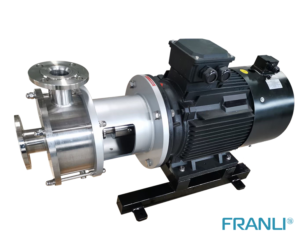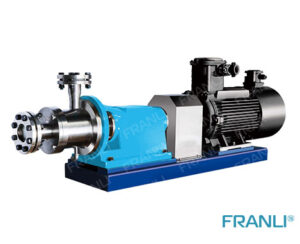What is an Inline Homogenizer?
Inline Homogenizer
An inline homogenizer, also known as an inline mixer or high-shear mixer, is a device used to effectively blend, emulsify, and disperse fluids. It is designed to handle high-viscosity liquids and create stable, uniform mixtures. Unlike traditional batch mixers, inline homogenizers operate continuously, allowing for greater productivity and consistency in processing.
Details of Inline Homogenizer
- Suitable for the material before the process
- Small energy consumption
- Large capacity
- Certain self-suction and low lift transport function
Application: Paint, Adhesive, Battery, Pharmaceutical industry, Cosmetic
Inline homogenizers are essential equipment used in various industries to achieve efficient mixing and homogenization of liquids. They are widely utilized in food and beverage production, pharmaceutical manufacturing, chemical processing, and wastewater treatment.
How Does an Inline Homogenizer Work?
Inline homogenizers utilize high-speed mechanical forces to break down particles and create droplets within the liquid media. The homogenizer consists of a rotor-stator assembly, typically composed of several fine-toothed rotor blades within a stationary stator. As the liquid flows through the narrow gap between the rotor and stator, intense shear forces are generated, resulting in the desired homogenization.
Applications of Inline Homogenizers
1. Food and Beverage Industry: Inline homogenizers play a crucial role in food and beverage production, facilitating the blending of ingredients, emulsification of oils and fats, and dispersion of particles. They are widely used for producing sauces, dressings, mayonnaise, dairy products, beverages, and processed foods. Inline homogenizers enhance product quality by ensuring consistency, texture, and stability.
2. Pharmaceutical Manufacturing: In the pharmaceutical industry, inline homogenizers are vital for the formulation and production of medications. They are used to mix active pharmaceutical ingredients (APIs) with excipients, disperse insoluble drugs, and create stable emulsions. Inline homogenizers also find applications in drug delivery systems, such as liposomal formulations and nanoparticle suspensions.
3. Chemical Processing: Inline homogenizers are extensively utilized in chemical processing industries for blending, dispersing, and emulsifying various liquids. They are commonly employed in the production of paints, coatings, adhesives, lubricants, and specialty chemicals. The shear forces generated by inline homogenizers help to reduce particle size, enhance interfacial contact, and improve product performance.
4. Wastewater Treatment: In wastewater treatment plants, inline homogenizers are employed to efficiently mix chemicals with sewage or sludge. This ensures proper disinfection, neutralization of pH, and removal of suspended solids or pollutants. Inline homogenizers allow for rapid and thorough mixing, leading to more effective treatment processes and cleaner water.
Advantages of Using Inline Homogenizers
1. Increased Productivity: Inline homogenizers enable continuous processing, resulting in enhanced production rates and reduced processing time. They eliminate the need for batch-to-batch handling, leading to improved efficiency and productivity.
2. Consistent Quality: Inline homogenizers provide precise control over mixing parameters, ensuring uniformity and consistency in the final product. They enable effective dispersion and reduction of particle size, resulting in improved product quality.
3. Flexibility and Versatility: Inline homogenizers can handle a wide range of viscosities and can be easily integrated into existing pipelines or processing systems. They offer adjustable settings for varying process requirements, making them versatile for different applications.
4. Energy Efficiency: Due to their continuous operation and streamlined design, inline homogenizers consume less energy compared to batch mixers. They minimize wastage, reduce production costs, and contribute to sustainable manufacturing practices.
Inline homogenizers are essential tools for achieving efficient mixing, emulsification, and dispersion in various industries. With their ability to process high-viscosity liquids continuously, they offer improved productivity, consistent quality, and energy efficiency. From food and beverage production to pharmaceutical manufacturing and chemical processing, inline homogenizers play a crucial role in ensuring uniformity and stability in the production of countless products. As these industries continue to evolve, the demand for inline homogenizers will undoubtedly grow, leading to further technological advancements and innovations in this field.
Welcome to send inquiry to us and let’s make a win win business together !
Guidelines For High Shear Mixer
The mixing device of the high shear mixer is a rotor with four blades, which rotates at a high speed in a stationary stator to complete the entire stirring and mixing process.

High Shear Mixers: A Guide to Applications in the Cosmetics Industry
A high shear mixer is one of the most versatile pieces of equipment used in the cosmetic industry. It is designed to mix, emulsify, disperse, and homogenize a wide range of cosmetic products.

What is a High Shear Emulsifier?
High shear emulsifiers are innovative and efficient machines that are used in various industries for the purpose of emulsification, homogenization, and particle size reduction.

What is an Inline Homogenizer?
An inline homogenizer is a machine that is used to mix and blend different substances together to create a uniform mixture. It is an essential tool in the manufacturing industry, particularly in the production of food, pharmaceuticals, and cosmetics.

What is an Inline Emulsifier?
An inline emulsifier is a type of high shear mixer that is designed to create a stable emulsion by breaking down the droplets of one liquid into smaller droplets and dispersing them throughout the other liquid.

High Shear Mixer: An Essential Tool for Efficient Mixing
A high shear mixer is a device that is used to mix, emulsify, disperse, and homogenize materials. It is a versatile tool that can be used in a variety of industries such as food, pharmaceuticals, cosmetics, and chemical manufacturing.

High Shear Mixers: Experimental & Production
High-shear mixers are primarily used in industry to produce standard mixtures of ingredients that do not mix naturally. When the total fluid of the material is composed of two or more liquids, after the work of the high-shear mixer, an emulsion is finally formed.

